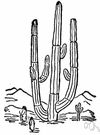saguaro
(redirected from saguaros)Also found in: Thesaurus, Encyclopedia.
Related to saguaros: Saguaro National Park, chollas
sa·gua·ro
(sə-gwär′ō, -wär′ō)n. pl. sa·gua·ros
1. A very large cactus (Carnegiea gigantea) of the Sonoran Desert, having ribbed upward-curving branches, white funnel-shaped flowers, and edible red fruit.
2. The fruit of this cactus.
[American Spanish saguaro, sahuaro, of Uto-Aztecan, perhaps Piman, origin.]
American Heritage® Dictionary of the English Language, Fifth Edition. Copyright © 2016 by Houghton Mifflin Harcourt Publishing Company. Published by Houghton Mifflin Harcourt Publishing Company. All rights reserved.
saguaro
(səˈɡwɑːrəʊ; səˈwɑː-) orsahuaro
n, pl -ros
(Plants) a giant cactus, Carnegiea gigantea, of desert regions of Arizona, S California, and Mexico, having white nocturnal flowers and edible red pulpy fruits
[Mexican Spanish, variant of sahuaro, an Indian name]
Collins English Dictionary – Complete and Unabridged, 12th Edition 2014 © HarperCollins Publishers 1991, 1994, 1998, 2000, 2003, 2006, 2007, 2009, 2011, 2014
sa•gua•ro
(səˈgwɑr oʊ, -ˈwɑr oʊ)n., pl. -ros.
a tall, horizontally branched cactus, Carnegiea (or Cereus) gigantea, of Arizona and neighboring regions yielding a useful wood and bearing an edible fruit.
[1855–60, Amer.; < Mexican Spanish saguaro, sahuaro]
Random House Kernerman Webster's College Dictionary, © 2010 K Dictionaries Ltd. Copyright 2005, 1997, 1991 by Random House, Inc. All rights reserved.
ThesaurusAntonymsRelated WordsSynonymsLegend:
Switch to new thesaurus
| Noun | 1. |  saguaro - extremely large treelike cactus of desert regions of southwestern United States having a thick columnar sparsely branched trunk bearing white flowers and edible red pulpy fruit saguaro - extremely large treelike cactus of desert regions of southwestern United States having a thick columnar sparsely branched trunk bearing white flowers and edible red pulpy fruitcactus - any succulent plant of the family Cactaceae native chiefly to arid regions of the New World and usually having spines Carnegiea, genus Carnegiea - caryophylloid dicot genus with only one species: saguaro |
Based on WordNet 3.0, Farlex clipart collection. © 2003-2012 Princeton University, Farlex Inc.